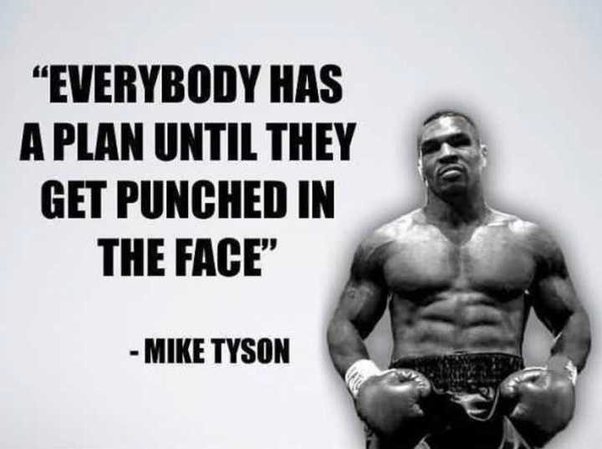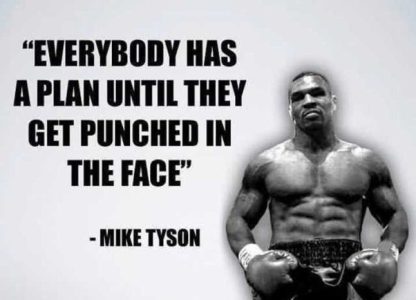Let’s take the first question, that broad and complex question – “Can we teach leadership?” Let’s attempt an answer, borrowing from John Kotter’s familiar framework, and ask three narrower, less complex questions.
- Can you teach someone to articulate a compelling vision? Arguably yes.
- Can you teach someone the skills required to align people around said vision? Arguably yes.
- Can you teach someone how to motivate people to execute said vision? Arguably yes.
Arguably yes. Though not to suggest the broad and complex task of leadership is exactly that.
However, here is my challenge. This is “planned for” approaches of leadership. Prospective. And leadership is just not that orderly, predictable or linear. Whilst planning is critical, plans themselves, are almost useless.
Everybody has a plan until they get punched in the face.
Mike Tyson
Essentially, the moment the planning is complete, the plan itself becomes largely outdated. My position, a complex-adaptive position, is that it is how leaders and organisations react and respond to what they can not anticipate, that is potentially most important. How resources are deployed, how time is allocated, what is actioned, what is not, that remains the most important decision for leaders? So I went in search of how do leaders assign their time? Sure enough, the most prized resource – time.
According to Michael Porter and Nitin Nohria, leaders (in this case CEOs) spend 36% of their time in reactive mode, responding to unfolding events.
Here is the connection. The prompt for this post is the common and often impossible “in-tray task.” Too many tasks and not enough time. Some complex, some scheduled, a fair few are unforeseen (of disastrous), some temptingly simple, some interconnected… the task, to prioritise your time. The “in-tray task” itself, an assessment tool of one’s leadership acumen and ability to prioritise time. (Quite different to the prospective planning tasks of visioning, aligning and motivating.)
Leadership or leading?
Can we teach prospective leadership? Arguably yes. However should we be considering leading? Linking back to the impossible in-tray task. I would suggest we should. Especially if time resource is so limited or a constraint.
In approaching the in-tray task, and day-to-day productivity, to help me manage and allocate my time and decide which tasks need my attention, I employ the trusted Eisenhower 2×2 matrix. Then, once tasks are assigned, they can be prioritised within the quadrants. What Porter and Nohria add is forethought to the likelihood the tasks will increase or decrease in significance over time.
| Significant at the start. Stay small Watch and wait | Significant at the start. Increasing. Be all-in |
| Small issues. Remain small Don’t get drawn in | Small issue. Becoming significant. Nip it in the bud |
Think small issues likely to remain small (Don’t get drawn in) versus significant issues likely to remain significant (Be all-in).
Then there are small issues that might become significant (Nip these in the bud). The advice here is for leaders to pay careful attention to small signs of discontent that have the potential to fester and grow. Listen carefully. Finally significant issues that are likely to diminish over time (Don’t overreact, do not fuel the fire. Watch and wait).
Leading as opposed to leadership
So the question then is, can you teach someone ‘sensing, sizing, and responding’ skills so that leaders react effectively to unfolding dynamic events in the moment?
Sensing
Time is limited – we know that. Leaders need to manage the information flow yet stay tuned. They need to intentionally listen and create the psychological safety necessary for people to share difficult news. Porter and Nohria suggest that “sense making” helps leaders process complex, ambiguous situations and that this expertise improved with practice.
Sizing
This is simply putting the issues in the correct quadrant. Sizing is largely pattern recognition and forecasting. Experience and expertise is therefore required.
Responding
This is what all leaders do, most days. However, with unfolding events, leaders are sensing and sizing all the time. According to Porter and Nohria, success leading involve embracing multiple, even competing, interpretations and solutions, rather than pursuing a fixed trajectory. Over-commitment opposes flexibility and the ability to adapt to emerging challenges
Conclusions
Michael Porter and Nitin Nohria’s research emphasises the importance of prioritising time and resources – however it also spotlights the potential significance of tasks over time.
Given leaders spending more than a third of their time reacting to unfolding events – we would be wise to allocate just time 70% of our available time resource.
Leadership is prospective whereas leading is responsive-adaptive.
Developing leading skills requires exposure to leading opportunities.
When tackling an impossible in-tray task – I will offer forethought to the likelihood the tasks will increase or decrease in significance over time.



